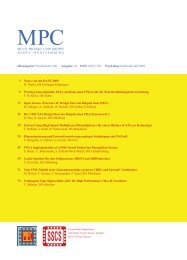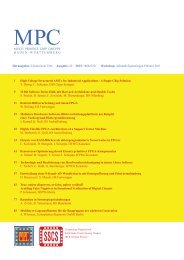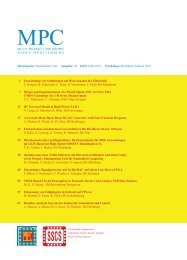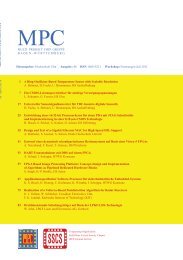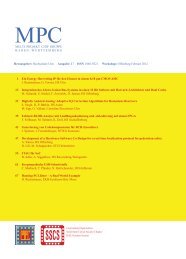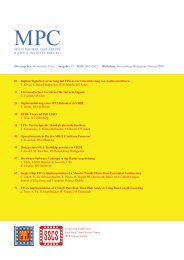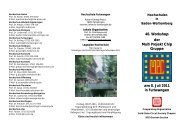[Geben Sie hier die Überschrift ein] - MPC
[Geben Sie hier die Überschrift ein] - MPC
[Geben Sie hier die Überschrift ein] - MPC
- TAGS
- mpc.belwue.de
Erfolgreiche ePaper selbst erstellen
Machen Sie aus Ihren PDF Publikationen ein blätterbares Flipbook mit unserer einzigartigen Google optimierten e-Paper Software.
Figure 6: Rectifier with cross coupled NMOS transistors.<br />
The power rectifier must be kept in the allowed operational<br />
area by the above circuit. The output of the<br />
rectifier is also used to supply the ESD protection<br />
circuits in the pads, which are MOS diodes connected<br />
to ground on one side and to the output of the power<br />
rectifier on the other side. The input voltages can by<br />
this never be larger than the output of the power rectifier<br />
plus the threshold of the diodes (ca. 0.7 V). So the<br />
output of the power rectifier is the highest voltage in<br />
the circuit.<br />
Clamping of the antenna signals must be hard<br />
enough to protect the circuit against breakdown and<br />
disturbance. It is not expected that the demodulation<br />
works under such overvoltage conditions. In normal<br />
operation the protection circuit must be inactive and<br />
shall not draw any current. The circuit is designed for<br />
a hard clamping, starting at 3.5 V and limiting the<br />
voltage to 3.7 V under normal conditions.<br />
IV. POWER SUPPLY<br />
The power supply unit consists of the rectifiers,<br />
bandgap reference circuits and LDO regulator.<br />
A. Rectifier<br />
The power rectifier shown as block B10 in figure 3<br />
is used to supply the low drop out regulator connected<br />
to it, which in turn is used to drive any external circuitry.<br />
The output is also used for load modulation, so<br />
for short intervals, the output voltage is loaded and<br />
this small interference has to be suppressed by the<br />
LDO as far as possible. A load capacitance at the<br />
external supply helps to bridge these intervals.<br />
The communications chain has its own rectifier,<br />
supplying the bandgap-circuitry, clock recovery circuit,<br />
demodulation and field detection circuit. The<br />
comparator, used for demodulation, is supplied by the<br />
bandgap regulated voltage and by this independent on<br />
range and temperature influences.<br />
28<br />
REALIZATION OF AN RFID FRONT END IC FOR ISO 15693<br />
STANDARD IN UMC CMOS 0.18 µM TECHNOLOGY<br />
Figure 7: Curve showing PTAT and CTAT voltages [6].<br />
Figure 8: Band Gap reference (Vref).<br />
Both the rectifiers used are typical full wave bridge<br />
rectifiers which are built by using four cross connected<br />
NMOS transistors as shown in figure 6.<br />
The (W/L) ratio of the rectifier transistors are made<br />
large (800:1 for block B10 in figure 3 and 200:1 for<br />
block B3 in figure 3 respectively) in order to get a<br />
small voltage drop and a good efficiency.<br />
B. Bandgap reference<br />
The purpose of a bandgap voltage reference is to deliver<br />
a fixed output voltage which is almost supply<br />
voltage and temperature independent. As shown in<br />
figure 7 the reference voltage is generated by adding<br />
two voltages, one having a positive and the other a<br />
negative temperature coefficient. When temperature<br />
increases, VBE linearly decreases and Vt (thermal voltage)<br />
linearly increases, which makes the Vref almost<br />
constant. The voltage obtained is first order independent<br />
of temperature. Figure 8 shows the type of band<br />
gap reference circuit used here. The reference voltage<br />
Vref is given by the following equation,<br />
Vt<br />
⋅ln(<br />
N)<br />
Vref<br />
= VBE<br />
+ ⋅ R2<br />
(3)<br />
R1<br />
where Vt is the thermal voltage which is 26 mV at<br />
300 °K and N denotes the number of BJTs in parallel<br />
which is 8 in this design. Now if we consider a current<br />
Ix is flowing through the BJT X. The same current Ix is<br />
also flowing through N transistors connected in parallel,<br />
identical to X.


![[Geben Sie hier die Überschrift ein] - MPC](https://img.yumpu.com/8654082/31/500x640/geben-sie-hier-die-uberschrift-ein-mpc.jpg)
